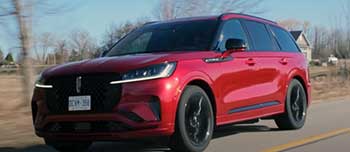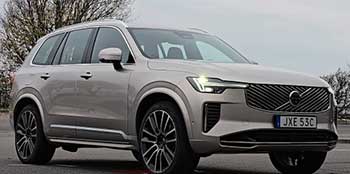As a car enthusiast and parent navigating the luxury SUV market, I set out to compare two standout contenders: the 2025 Lincoln Aviator and the 2025 Volvo XC90. My goal is to help you decide which of these premium three-row SUVs best fits your lifestyle, whether you prioritize performance, comfort, safety, or efficiency. Through my first-hand exploration, I’ll break down their pros and cons, sharing insights from test drives and research to guide your choice in this competitive segment.
Comparison Table of Lincoln Aviator vs. Volvo XC90
| Feature | Lincoln Aviator (2025) | Volvo XC90 (2025) |
| Starting MSRP | $57,095 | $57,100 |
| Engine | 3.0L Twin-Turbo V6, 400 hp, 415 lb-ft torque | 2.0L Turbo 4-cylinder (B5), 247 hp, 258 lb-ft torque |
| Hybrid Option | Grand Touring Plug-In Hybrid, ~21 miles electric range | Recharge Plug-In Hybrid (T8), 455 hp, ~32 miles electric range |
| Transmission | 10-speed automatic | 8-speed automatic |
| Fuel Economy (City/Hwy) | 17/24 mpg (standard), 23/24 mpg (PHEV) | 22/27 mpg (B5), 58 MPGe (Recharge) |
| Towing Capacity | 5,600 lbs (standard), 6,700 lbs (properly equipped) | 5,000 lbs |
| Cargo Space | 18.3 cu. ft. behind 3rd row, 77.7 cu. ft. max | 11.2 cu. ft. behind 3rd row, 65.5 cu. ft. max |
| Seating | 6 or 7 passengers | 6 or 7 passengers |
| Infotainment | 10.1-inch touchscreen, SYNC 3, BlueCruise | 9.0-inch touchscreen, Google Built-in, Pilot Assist |
| Safety Features | Lincoln Co-Pilot360, Active Park Assist Plus | IntelliSafe, Pilot Assist, WHIPS |
| Warranty | 4 yrs/50,000 miles basic, 6 yrs/70,000 miles powertrain | 4 yrs/50,000 miles basic, 8 yrs/100,000 miles hybrid components |
My Journey with Luxury SUVs
I’ve always been drawn to luxury SUVs for their blend of style, comfort, and practicality. As a parent with young kids, I need a vehicle that’s spacious enough for car seats, safe for my family, and powerful enough to make long drives enjoyable. The Lincoln Aviator and Volvo XC90 caught my eye because they promise all that and more, each with a distinct personality. The Aviator exudes American opulence, while the XC90 channels Scandinavian minimalism. My mission was to explore these vehicles through test drives, spec sheets, and real-world considerations to see which one truly delivers.
Exterior Design A Matter of Style

The Lincoln Aviator grabs attention with its bold, commanding presence. Its sleek lines, massive grille, and LED headlights give it a stately look, like a modern-day luxury liner.
I felt its design screamed confidence, especially with the optional Jet Appearance Package, which adds a sporty edge.
During my test drive, the Aviator’s illuminated door handles and projected Lincoln logo welcome mat made me feel like I was stepping into something special.

The Volvo XC90, on the other hand, takes a subtler approach.
Its Thor’s Hammer LED headlights and clean, minimalist lines reflect Scandinavian elegance.
The crystal gear selector inside feels like a piece of art, and the overall aesthetic is understated yet sophisticated.
I appreciated how the XC90’s design felt timeless, avoiding the flashiness of some competitors. However, its smaller grille and less imposing stance didn’t turn heads quite like the Aviator.
Aviator Pros:
- Bold, luxurious design; unique lighting features; premium aesthetic with customization options.
Aviator Cons:
- Stocky, square shape may feel bulky for some; less approachable than the XC90’s sleek profile.
XC90 Pros:
- Elegant, minimalist design; futuristic headlights; premium Scandinavian vibe.
XC90 Cons:
- Less commanding presence; design may feel too understated for those seeking bold luxury.
Interior Comfort and Space
Stepping into the Aviator’s cabin felt like entering a high-end lounge. The available 30-way Perfect Position seats with Active Motion massaged my back on long drives, a feature I found transformative for comfort. With 43 inches of front-row legroom and 39 inches in the second row, my family had plenty of space. The third row, however, offered just 29.2 inches of legroom, which felt cramped for adults but fine for kids.
Cargo space impressed me, with 18.3 cubic feet behind the third row and 77.7 cubic feet with seats folded, perfect for family road trips.

The XC90’s interior is a study in serene luxury.
Its leather upholstery and crystal accents create a calming atmosphere, though it lacks the Aviator’s opulent flair.
With 40.9 inches of front-row legroom and 37 inches in the second row, it’s slightly tighter than the Aviator. However, the third row’s 31.9 inches of legroom and 44.9 inches of hip room gave my kids more wiggle room.
Cargo space disappointed me slightly, with only 11.2 cubic feet behind the third row and 65.5 cubic feet max, trailing the Aviator.
Aviator Pros:
- Spacious first and second rows; luxurious materials; power-folding third row.
Aviator Cons:
- Tight third-row legroom; heavier curb weight impacts efficiency.
XC90 Pros:
- Roomier third row; serene cabin design; standard four-zone climate control.
XC90 Cons:
- Less cargo space; fewer premium seat adjustments compared to Aviator.
Performance and Driving Experience
Under the hood, the Aviator’s twin-turbo 3.0L V6 engine delivers a thrilling 400 horsepower and 415 lb-ft of torque, paired with a 10-speed automatic transmission. I felt the power immediately, whether merging onto highways or towing a trailer (up to 6,700 pounds when equipped). The optional Dynamic Handling Package with air bladders made the ride smooth, adapting to road conditions effortlessly. However, I noticed slight turbo lag during aggressive acceleration, as some reviews mentioned.
The XC90’s base B5 2.0L turbocharged four-cylinder, producing 247 horsepower and 258 lb-ft of torque, felt adequate but underpowered compared to the Aviator. Its 8-speed automatic was smooth but less refined. The Recharge Plug-In Hybrid (T8), with 455 horsepower, closed the gap, but I found its acceleration less visceral than the Aviator’s. The XC90’s lighter weight (4,589 lbs vs. Aviator’s 4,745 lbs) made it nimbler in city driving, and standard all-wheel drive handled snow well during my Midwest test drive.
Aviator Pros:
- Powerful V6 engine; higher towing capacity; smooth adaptive suspension.
Aviator Cons:
- Noticeable turbo lag; lower fuel economy (17/24 mpg).
XC90 Pros:
- Nimble handling; better fuel economy (22/27 mpg); strong hybrid option.
XC90 Cons:
- Less powerful base engine; fewer transmission gears.
Technology and Infotainment
The Aviator’s 10.1-inch SYNC 3 touchscreen was intuitive, with crisp graphics and seamless Apple CarPlay and Android Auto integration. I loved the standard 4G LTE Wi-Fi hotspot, perfect for keeping kids entertained on long drives. The available 28-speaker Revel Ultima 3D Audio System blew me away with its immersive sound. BlueCruise, Lincoln’s hands-free driving tech, made highway drives relaxing, covering 97% of controlled-access roads.
The XC90’s 9.0-inch portrait-oriented touchscreen felt modern but slightly less responsive. Its 10-speaker audio system (upgradable to 19-speaker Bowers & Wilkins) was excellent but didn’t match the Aviator’s audio clarity. Pilot Assist, Volvo’s semi-autonomous system, impressed me with its smooth lane-keeping and adaptive cruise control, though it’s not as comprehensive as BlueCruise. The standard panoramic roof added an airy feel, a feature requiring an upgrade on the Aviator.
Aviator Pros:
- Larger touchscreen; superior audio system; advanced BlueCruise tech.
Aviator Cons:
- Higher trims needed for some features; interface can feel complex.
XC90 Pros:
- Intuitive Pilot Assist; standard panoramic roof; sleek infotainment design.
XC90 Cons:
- Smaller touchscreen; fewer speakers; some features lag behind Aviator.
Safety Features
Safety is non-negotiable for me, and both SUVs deliver. The Aviator’s Lincoln Co-Pilot360 includes adaptive cruise control, blind-spot monitoring, and automatic emergency braking. Active Park Assist Plus made parallel parking a breeze, and the 360-degree camera was a lifesaver in tight spots. The Aviator earned a five-star NHTSA rating and outperformed the XC90 in IIHS side-impact tests.
The XC90’s IntelliSafe suite, with Pilot Assist, adaptive cruise control, and Whiplash Injury Protection System (WHIPS), is a safety benchmark. It also earned a five-star NHTSA rating and a Top Safety Pick+ from IIHS in prior years. However, some advanced features, like adaptive cruise, require higher trims on the Aviator but are standard on the XC90.
Read More: Lexus TX vs. Toyota Grand Highlander
Aviator Pros:
- Advanced parking aids; strong crash test results; comprehensive safety suite.
Aviator Cons:
- Some safety features not standard on base trim.
XC90 Pros:
- Standard advanced safety features; WHIPS for added protection; proven safety record.
XC90 Cons:
- Lacks Aviator’s parking assist; slightly weaker side-impact scores.
Fuel Economy and Efficiency
With gas prices always on my mind, the XC90’s base engine (22/27 mpg) outshone the Aviator’s (17/24 mpg). The XC90’s Recharge Plug-In Hybrid offered a 32-mile electric range, ideal for short commutes, while the Aviator’s Grand Touring hybrid managed about 21 miles. I appreciated the XC90’s efficiency for daily driving, but the Aviator’s hybrid felt more powerful, balancing efficiency with performance.
Aviator Pros:
- Strong hybrid performance; decent efficiency for its power.
Aviator Cons:
- Lower base fuel economy; shorter electric range in hybrid.
XC90 Pros:
- Better base and hybrid efficiency; longer electric range.
XC90 Cons:
- Less potent hybrid performance compared to Aviator.
Pricing and Value
The XC90 starts at $57,100, slightly undercutting the Aviator’s $57,095. However, the Aviator’s base trim feels more feature-rich, with a larger touchscreen and more powerful engine. Higher trims like the Aviator’s Black Label ($80,000+) and XC90’s Recharge Ultimate ($70,000+) cater to luxury seekers, but the Aviator’s longer powertrain warranty (6 years/70,000 miles vs. XC90’s 4 years/50,000 miles) added peace of mind. Maintenance costs, per RepairPal, favor the XC90 ($769/year vs. $879/year for Lincoln).
Aviator Pros:
- More standard features; longer warranty; competitive base price.
Aviator Cons:
- Higher maintenance costs; pricier top trims.
XC90 Pros:
- Lower starting price; cheaper maintenance; strong value in base trim.
XC90 Cons:
- Fewer standard features; shorter warranty.
My Test Drive Experience
Driving the Aviator felt exhilarating. Its V6 engine roared to life, making highway merges effortless, and the cabin’s quietness, thanks to Active Noise Control, was a game-changer for family trips. The XC90, while smooth and composed, lacked the same punch. Its hybrid model impressed me with its efficiency, but the base engine felt underwhelming. Parking the larger Aviator was trickier, but its 360-degree camera saved the day. The XC90’s nimble handling made city driving a breeze, especially in snowy conditions.
Also Read: Lincoln Continental vs. Lincoln MKZ
Which SUV Suits Your Needs?
If you crave power, space, and cutting-edge tech, the Aviator is your match. Its robust engine, spacious cargo area, and BlueCruise tech make it ideal for long drives and tech-savvy families. However, if fuel efficiency, safety, and minimalist luxury are your priorities, the XC90 shines with its hybrid range and standard safety features. Your choice depends on whether you lean toward American boldness or Scandinavian efficiency.
Frequently Asked Questions
The XC90 is 195.0 inches long, 69.9 inches tall, and 84.3 inches wide (with mirrors). The Aviator is larger at 199.3 inches long, 69.6 inches tall, and 89.9 inches wide, offering more cargo space but a slightly tighter third row.
It depends on your priorities. The Lincoln Aviator offers more power, cargo space, and advanced tech like BlueCruise, while the Volvo XC90 excels in fuel efficiency, third-row comfort, and standard safety features. Test drive both to decide.
The Lincoln Aviator outperforms the XC90 in power and cargo space. The Audi Q7 offers similar luxury with a sportier drive. The BMW X7 provides more interior space but at a higher price point.
Conclusion
Choosing between the Lincoln Aviator and Volvo XC90 comes down to what you value most in a luxury SUV. My journey revealed the Aviator’s edge in power, space, and tech, making it a thrilling choice for families who want bold performance. The XC90, with its efficiency and safety, suits those seeking a refined, eco-conscious ride. I hope my experience helps you find the perfect SUV for your adventures, whether you’re hauling kids or hitting the open road.

